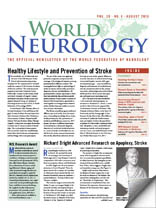
Jolynne Mokaya
Neurological disorders make up at least 25 percent of the global burden of disease and are responsible for an even greater proportion of persons living with disability (Silberberg and Katabira, 2006). Factors such as malnutrition, adverse perinatal conditions, malaria, human immunodeficiency virus and acquired immune deficiency syndrome (HIV/AIDS), meningitis, demographic transitions, increased road traffic accidents and persistent regional conflicts have increased the prevalence of neurological disorders in Sub-Saharan Africa (Silberberg and Katabira, 2006).
A study of Parkinson’s disease carried out in rural Tanzania showed that prevalence rates were higher than what has been previously reported from Sub-Saharan Africa. The crude prevalence rates were 30/100,000 (men), 11/100,000 (women) and 20/100,000 (combined) showing only a slight difference when compared to the prevalence rates with the U.K. population. This illustrates the fact that neurological diseases are equally a problem in Africa as they are in the Western world. Many Parkinson’s disease patients and many individuals with other neurological diseases in Sub-Saharan Africa may never be diagnosed or treated, with consequent reduction in their life expectancy and quality of life (Dotchin et al., 2008)
With the current increase of neurological diseases globally, health care professionals are expected to see an increasing number of patients living with neurologic conditions including dementia, stroke, epilepsy, Alzheimer’s and Parkinson’s disease. The World Health Organization identified a shortfall of 4.3 million trained health workers in 2006, with the biggest disparity in Sub-Saharan Africa.
With the current increase of neurological diseases globally, health care professionals are expected to see an increasing number of patients living with neurologic conditions including dementia, stroke, epilepsy, Alzheimer’s and Parkinson’s disease. Policymakers, therefore, must help ensure there are properly trained clinicians available to provide high-quality care (American Academy of Neurology Professional Association). The World Health Organization identified a shortfall of 4.3 million trained health workers in 2006, with the biggest disparity in Sub-Saharan Africa.
Kenya has an estimated population of 41 million, most of whom live in the rural areas (Index Mundi, 2012). Medical standards, such as income distribution, reveal huge differences between various segments of the population. Like many developing nations, there are too few health care providers for the growing population, and only 30 to 40 percent of all Kenyans have access to improved sanitation, clean water and decent health care (InterNations, nd).
Public (government service), private and missionary hospitals are the three major providers of health care in Kenya, with public hospitals being the major health care providers to the majority of the Kenyan population (Amayo, 2006). Kenyatta National Hospital is the largest public hospital, with 7.5 percent of all medical cases seen in this hospital being neurological illnesses (Kwasa 1992).
The HIV/AIDS pandemic has evolved to being the major clinical challenge of neurology practice in Kenya due to the rise of neurological complications associated with it. More than 60 percent of all hospital beds are occupied by HIV-related illness in public hospitals. On the other hand, non-communicable diseases with their neurological sequelae are becoming epidemic due to the changing pattern of lifestyle. Once considered rare, multiple sclerosis is now being diagnosed frequently, and age-related diseases are on the rise as the population ages offering major management challenges (Amayo, 2006).
With awareness of the massive burden associated with neurological disorders, it is recognized that neurological services and resources are disproportionately scarce especially in low income and developing countries (WHO, 2005). The situation in Kenya is worse; currently, there are only 11 neurologists with most of them in private practice and working in Nairobi. In Kenya, the majority of health care providers are nurses who receive little or no training in how to diagnose and treat the common neurologic conditions that present to them every other day. There is not a single nurse trained in neurology, nor is there a training institution of neurology for nurses in Kenya. Lack of mentorship makes it difficult for most nurses to be involved in neurology, and it is sad that the majority of nurses are not aware that they could specialize in neurology (Hooker, 2013).
Nurses bring an important voice and point of view to management and policy discussions. It is crucial to involve them not only in hospital management and patient care but also in being part of various organizations, societies and bodies promoting neurology worldwide.
Training of nurses is particularly important globally. In low income countries such as Kenya where few physicians exist, nurses are involved in making diagnostic and treatment decisions.
Previous training of nurses in Kenya concentrated on the cadre of enrolled nurses and registered nurses. However, with the increasing development of the society, a higher level of training for nurses has become necessary to meet the challenging demand for high-quality nursing care (NNAK, 2009). The health sector reforms that are currently being introduced in Kenya not only require highly qualified nurses but also highly specialized nurses for effective and successful implementation (Muga et al, nd). It is crucial and essential for nurses to be endowed with the necessary knowledge, skills and attitudes to be able to give quality service.
Availability of funds, scholarships, training opportunities and mentorship programs should also be made available to nurses and other health care providers in low income countries and regions with few or non-specialists in neurology, to encourage and have more health care providers train and specialize in neurology. •
References
1. Amayo E., (2006).Neurological letter from Kenya. Practical Neurology; Vol 6(4):261 doi:10.1136/jnnp.2006.097519
2. American Association of Neurology Professional Association. The critical role of neurologists in our health care system. (www.aan.com/advocacy/issues/tools/109.pdf, accessed 30 may 2013)
3. Dotchin C., Msuya O., Kissima J., Massawe J., et al. (2008). The prevalence of Parkinson’s disease in rural Tanzania. PubMed; Vol 23(11): 1567-672. doi: 10.1002/mds.21898
4. Hooker J., (2013). Nurturing Neuroscience and Neurology in Kenya and East Africa-Some reflections. Kenya Association of Physicians. (http://kapkenya.org/index.php?option=com_phocadownload&view=category&download =233:nurturing-neurology-and-neuroscience… &id=13:17th-annual-scientific-conference &Itemid=127, accessed 30 May 2013).
5. Index Mundi, (2012). Kenya’s population. (www.indexmundi.com/kenya/population.html, accessed 30 May 2013)
6. InterNations,(nd). Health care in Kenya.(www.internations.org/kenya-expats/guide/life-in-kenya-15768/healthcare-in-kenya-2, accessed 30 May 2013)
7. Kwasa T., (1992). The pattern of neurological disease at Kenyatta National Hospital. East African Medical Journal;69(5):236-9.
8. Muga R., Kizito P., Mbaya M., Gakuru T., (nd). Overview of health systems in Kenya.(http://www.measuredhs.com/pubs/pdf/SPA8/02Chapter2.pdf, accessed 28 May 2013)
9. National Nurses Association Of Kenya, (2009). Strategic plan 2009-2014. (www.nnak.or.ke, accessed 29 may 2013)
10. Preamble to the Constitution of the World Health Organization as adopted by the International Health Conference, 1946. In: Basic documents, 45th ed. Geneva, World Health Organization, 2005
11. Silberberg D., Katabira E., (2006). Disease and Mortality in Sub-Saharan Africa: Neurological Disorders, 2nd edition, Bookshelf ID: NBK2295PMID: 21290656
12. World Health Organization. Neurological disorders: public health challenges, (2006).
Mokaya is a final year student in the bachelor’s degree program in Nursing Sciences at the University of Nairobi. The University of Nairobi is the pioneer institution of university education in Kenya, situated in Nairobi. It is committed to quality through teaching, research and creative works, fostering an intellectual culture that bridges theory with practice, and producing holistic graduates prepared for a life of purpose, service and leadership.
